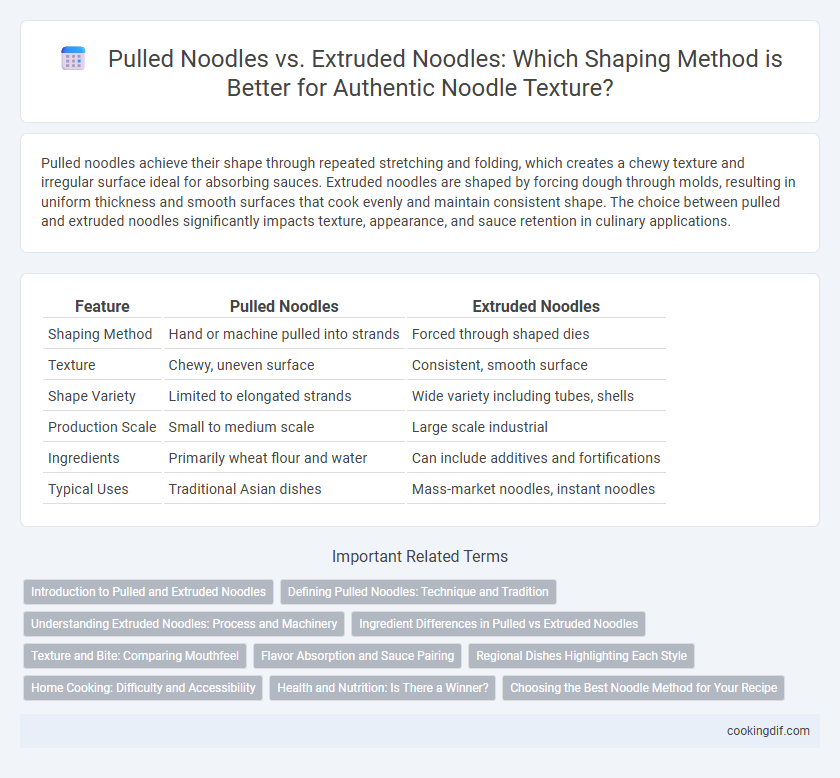Pulled noodles achieve their shape through repeated stretching and folding, which creates a chewy texture and irregular surface ideal for absorbing sauces. Extruded noodles are shaped by forcing dough through molds, resulting in uniform thickness and smooth surfaces that cook evenly and maintain consistent shape. The choice between pulled and extruded noodles significantly impacts texture, appearance, and sauce retention in culinary applications.
Table of Comparison
| Feature | Pulled Noodles | Extruded Noodles |
|---|---|---|
| Shaping Method | Hand or machine pulled into strands | Forced through shaped dies |
| Texture | Chewy, uneven surface | Consistent, smooth surface |
| Shape Variety | Limited to elongated strands | Wide variety including tubes, shells |
| Production Scale | Small to medium scale | Large scale industrial |
| Ingredients | Primarily wheat flour and water | Can include additives and fortifications |
| Typical Uses | Traditional Asian dishes | Mass-market noodles, instant noodles |
Introduction to Pulled and Extruded Noodles
Pulled noodles are handmade by stretching and folding dough repeatedly, creating thin, elastic strands known for their chewy texture and artisanal quality. Extruded noodles are produced by forcing dough through shaped dies, allowing for consistent shapes and efficient mass production, ideal for various noodle types like macaroni or vermicelli. Both methods influence texture and shape, with pulled noodles emphasizing craftsmanship and extruded noodles offering versatility and uniformity.
Defining Pulled Noodles: Technique and Tradition
Pulled noodles are crafted by repeatedly stretching and folding dough strands, creating a smooth, elastic texture unique to this handmade technique. This traditional method contrasts with extruded noodles, which are shaped by forcing dough through molds, resulting in uniform shapes and textures. The artisanal stretching process of pulled noodles emphasizes skill and tradition, offering a distinct culinary experience compared to the mechanical precision of extruded noodles.
Understanding Extruded Noodles: Process and Machinery
Extruded noodles are produced by forcing dough through dies under pressure using specialized extrusion machinery, which allows for consistent shaping and texture. The extrusion process enables precise control over noodle thickness, length, and cross-sectional design, making it ideal for creating complex shapes that are difficult to achieve with pulled noodles. Industrial extruders often incorporate adjustable parameters like temperature, pressure, and screw speed to optimize dough consistency and product quality.
Ingredient Differences in Pulled vs Extruded Noodles
Pulled noodles are traditionally made with high-gluten wheat flour and water, which provides the necessary elasticity and strength for stretching and folding without breaking. Extruded noodles rely on a dough composed of wheat flour mixed with water and sometimes additional binding agents like eggs or starches to facilitate shaping through a mechanical extrusion process. The ingredient composition in pulled noodles emphasizes gluten development for texture, while extruded noodles often incorporate additives to enhance dough plasticity and structure during shaping.
Texture and Bite: Comparing Mouthfeel
Pulled noodles feature an elastic texture and a chewy bite due to the dough being repeatedly stretched and folded, creating layers that enhance mouthfeel. Extruded noodles have a denser and more uniform texture, with a firmer bite resulting from the dough being forced through shaped dies. The differing production methods directly impact the tactile sensations, with pulled noodles offering a more delicate chew compared to the consistent resilience of extruded noodles.
Flavor Absorption and Sauce Pairing
Pulled noodles have a porous, chewy texture that enhances flavor absorption, making them ideal for rich, thick sauces such as spicy Sichuan or savory peanut-based blends. Extruded noodles typically offer a denser, uniform shape with a smoother surface, which pairs well with lighter sauces like broth-based or simple soy-seasoned dressings, as they hold flavors more on the exterior. The choice between pulled and extruded noodles depends on the desired sauce intensity and taste integration in culinary applications.
Regional Dishes Highlighting Each Style
Pulled noodles, known for their hand-stretched texture, are essential in regional dishes like Chinese Lanzhou beef noodle soup, emphasizing elasticity and chewiness. Extruded noodles, produced by forcing dough through shaped dies, are common in Italian pastas and Korean ramyeon, offering uniform thickness and the ability to create diverse shapes. Each shaping method highlights distinct culinary traditions, with pulled noodles favored in long, ribbon-like preparations and extruded noodles serving versatile forms suitable for soups and stir-fries.
Home Cooking: Difficulty and Accessibility
Pulled noodles require skillful hand-pulling techniques that demand practice, making them less accessible for home cooks without experience. Extruded noodles, shaped by machines, offer a consistent texture and are easier for beginners to prepare at home. The simplicity of extruded noodle preparation enhances accessibility, while pulled noodles provide a unique texture but require higher culinary skill.
Health and Nutrition: Is There a Winner?
Pulled noodles are traditionally handmade, preserving natural gluten structures, which may enhance digestibility and provide a denser texture with fewer additives. Extruded noodles are machine-processed, often incorporating additional ingredients and additives, potentially affecting glycemic index and nutrient availability. From a health and nutrition perspective, pulled noodles generally offer a cleaner ingredient profile, but extruded noodles can be fortified with vitamins and minerals to boost their nutritional value.
Choosing the Best Noodle Method for Your Recipe
Pulled noodles offer a chewy texture and a unique elasticity by stretching dough repeatedly, ideal for hand-crafted, artisanal dishes requiring precise thickness control. Extruded noodles are produced by forcing dough through molds, enabling consistent shapes and uniform thickness, making them suitable for mass production and recipes needing uniformity. Selecting the best noodle method depends on the desired texture, production scale, and recipe requirements, with pulled noodles favored for traditional, customizable dishes and extruded noodles for efficiency and shape variety.
Pulled noodles vs extruded noodles for shaping Infographic

 cookingdif.com
cookingdif.com